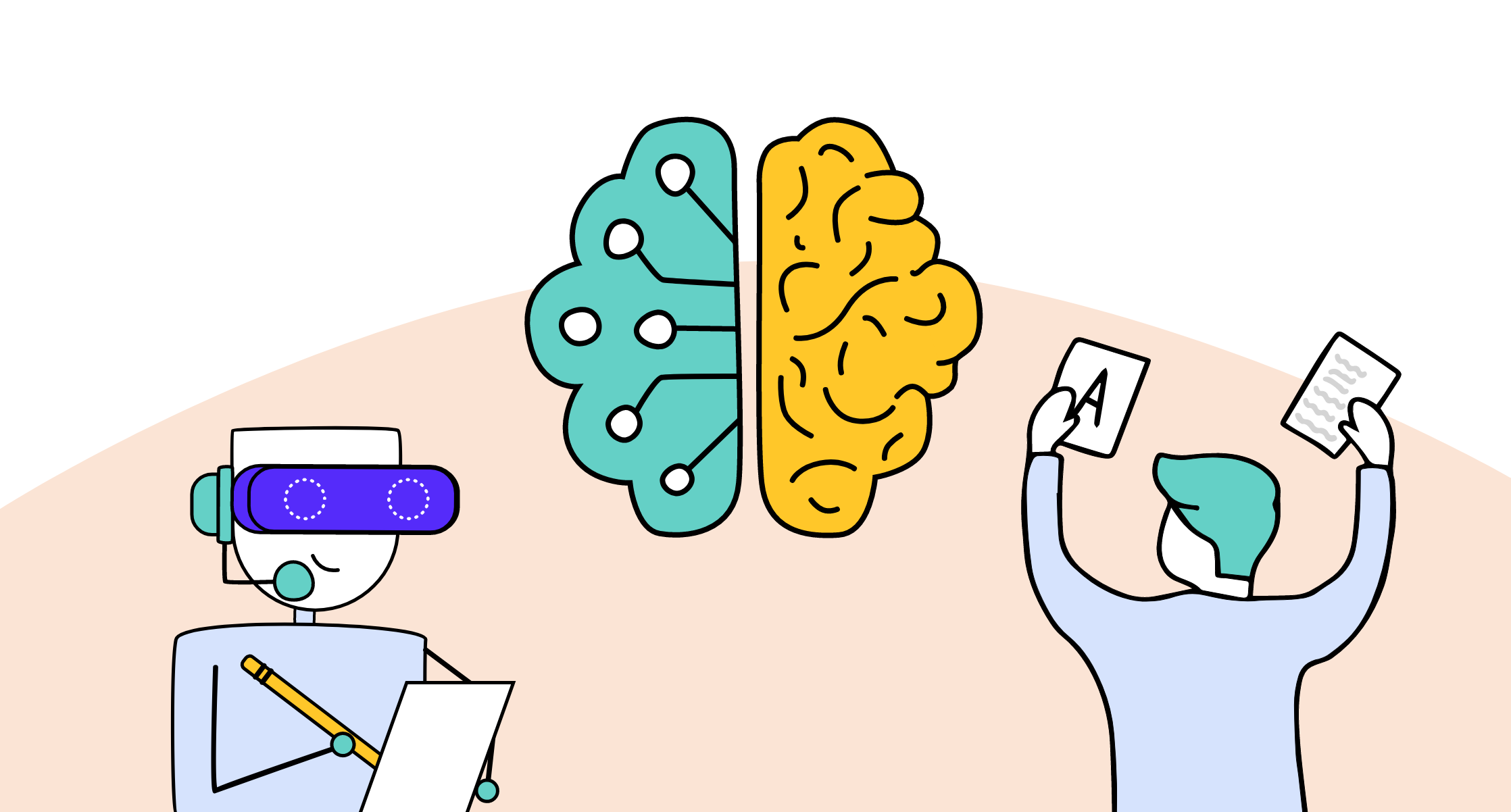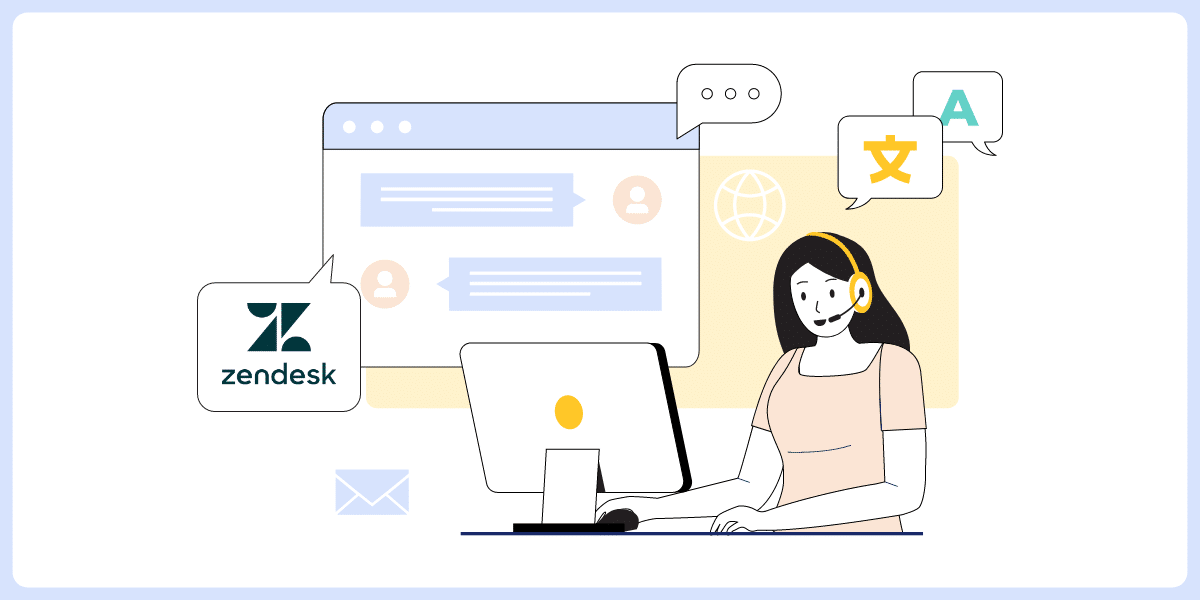Home » AI-Powered vs. Human » AI-powered or Human Translations? A complete guide to choosing the best for your business.
AI-powered or Human Translations? A complete guide to choosing the best for your business.
- | Amit Shivani

Table of Contents
If culture was a house, then language was the key to the front door, to all the rooms inside.
Khaled Hosseini
To unlock a house called ‘global market’, multilingual communication integration or localizing the customer experience is the only key to its door. Although localization is a pretty nifty way to break into a new market, it’s not as simple as it sounds. Transitioning an entire business to a new language comes with its own hurdles and complications. Think of the complex nexus when it comes to multiple languages! This is precisely why only 19% of customer contact centers offer support in multiple languages.
But thankfully, day-to-day advancements in technology are bridging the gap between a business & its localization requirements. Needless to say, AI-powered or automated translation is the first thing that comes to mind when talking about translation and technology together.
In this blog post, we’re going to provide you with a checklist guide that will help you choose between human and AI-powered translations. Before we jump into how to choose between AI-powered and human translations, let’s first get a comprehensive understanding of the two.
What Is AI-powered Translation?
Deciphering by its name, “AI-powered Translation” or “Machine Translation” simply means the process of translating texts from one language to another with the help of electronic devices and artificial intelligence.
Quick note: People often mistake AI-powered Translations with Computer-Aided Tool (CAT), but they couldn't be more different from each other. While a CAT only helps human translators to translate a text from one language to another, AI-powered Translation needs no human input during the translation process and translates the source text automatically. Also, note that both CAT and MT were made to make the translation process more productive and fast but both have their own limitations.
AI-powered Translation was introduced in 1954 and has massively evolved since then. But even with such advancements, machines are yet to become 100% reliable when it comes to accuracy. Machine-translated texts need human intervention if someone wants full-proof translated content in different languages.
What is The Need for AI-powered Translation
Our world is full of vibrant diversities, cultures, and languages, isn’t it? Apparently, businesses don’t want to lose this large pool of potential markets all around. They want to excel at the customer experience among their target audience, and engaging with them in their preferred language is the first thing they would always want to do.
Globalization and localization have a chicken-and-egg relationship, that is brands can only globalize if they localize, and the need to localize comes from the inherent dream to globalize. Thus, to expand globally, businesses need to translate their entire business spectrum into the languages their target audiences speak. But this transition requires huge investment and resources that aren’t easily available.
For example,
- It’s very difficult to find sales representatives who are fluent in more than one language.
- Scalability issues while translating documents and digital collateral in bulk.
- Hiring human translators for multiple languages requires a significant commitment in terms of finances, time, and quality analysis.
- Machine translation makes the process faster.
- Automated translation with human proofreading makes the translation work even more productive as well as accurate.
What Is Human translation?
As the name aptly suggests, Human Translation is the translation of text from one language to another. A native expert in both languages is considered ideal for the same. This way, the translator can ensure that the translated text maintains the required linguistic, cultural, and industry-specific accuracy.
Human Translations have the benefit of being 100% accurate depending upon the translator’s proficiency in both languages and industry expertise. However, the flip side is that it takes longer compared to AI-powered Translations. Additionally, without a proper Translation Management System (TMS), managing several languages, co-ordinating with multiple translators, the back and forth on communication channels to maintain brand tone often becomes taxing and reduces productivity.
Why Do We Need Human Translation
“When we have become technologically advanced and can translate our texts automatically, why are we still talking about human translation anyway?”
You might have come across such a question after reading about AI-powered and Human translations. But there are several reasons why human translation is still relevant in 2022:
- Machine translations aren’t full-proof. Businesses can’t rely completely on AI as language mistakes would backfire on them and might tarnish their brand image. But human translators can upskill themselves, modify, and edit the content with close to no mistakes in the final result.
- Machines only run on mathematical algorithms and scientific calculations. Whereas humans understand the emotional context of a text and can translate it accordingly. This gives human translation an edge over machines, especially with content that requires creativity, ideas, and emotions.
- Machines only convert a piece of content from one language to another, word-by-word. It has little to no sense of syntaxes, idioms, grammar, and conventions. Whereas human translators pay attention to every little detail of a text and use their thinking ability to keep the context in place while translating it.
- With machines, information security gets a bit vulnerable. Hence, many businesses still prefer human translators for their highly confidential documents.
AI-powered Translation Vs Human Translation: Which One Is Better For Your Business?
Whether you should choose a machine or human translation depends on various factors. Every business functions differently. Their current translation requirements, target groups, business niche, resource capacity, and long-term plans are unique and constantly evolving. This is why you must do a quick analysis before making any major localization-related decisions to refrain from getting into any complexities that may occur in the beginning or at a later stage.
7 Questions To Ask Before Choosing Between Automated Translation & Human Translation
- Which languages are you planning to target?
- Are there enough human translators in your network who are fluent in those languages? If yes, how much would an individual human translator charge?
- What is the volume of brand collateral you need to translate?
- What is your timeline to finish the desired-content translation? How many human translators would you need to achieve the target by the pre-determined timeline?
- How much time and cost would a translation agency charge?
- Would your firm need the translation work on a recurring basis? For example, what would be the most efficient way to set up a localized live-chat system in your day-to-day customer support to enhance the customer experience? Outsourcing it to a language service provider, hiring internal translators, or using a translation management system?
- Is your budget in line with the overall cost estimation?
When To Choose AI-powered Translation
Look into this checklist and decide whether you should opt for AI-powered or automated translation:
-
Language Accuracy:
Choose AI-powered translations for plain, simple texts that don't need much tweaking with respect to the language it is getting translated to. For example, if you want to translate the features of your product and the text is pure technical, you can use machine translation to speed up -
Risk appetite:
If your content can digest some minute grammatical errors here and there, you can rely on machine translation. You can hire human proofreaders to cross-check the translated content for accuracy and avoid blunders in your content. -
Content type:
Analyze your content type and its requirements. For example, if you’re translating your product knowledge base or a simple user guide, you can rely on AI-powered translations with this. Such content does not need any emotion-driven sentences or syntaxes that machines are pretty good at translating. -
Recurring work:
If your translation work is recurring and requires speed, relying on human translators 24*7 is not feasible for you. This might include customer chat support, reports, description of plain events, etc.
When To Opt For Human Translation
Check these pointers to decide when to hire human translators for better outcomes:
-
Language Accuracy:
Machines run on algorithms, and several times it doesn’t get a sense of translating the syntaxes with respect to the context of the text. And some industries can’t risk having such mistakes. For example, an organization needs their clinical trial form translated to include multilingual participants. Now, the content is specific and very important, and if it is not translated properly, it can cause legal issues and hamper the brand's image. If your requirements are of this sort, you should go with human translators. -
Risk appetite:
If you are not willing to compromise on the quality and refrain from any sporadic minor linguistic or grammatical mistakes in your content, you should take help from human translators. -
Creativity requirements:
Geo-targeted content can engage an audience 6X more effectively compared to a uniform post across the globe. Thus, when your content requires creativity, you should consider human translators who know your target audience's language, culture, and emotions. For example, if you want to localize a particular marketing campaign, you would always want the translation to not deviate from its original framework and context. A human translator can do more justice to such content than a machine translation.
Similarly, if it is a simple "hello" in Spanish, you can opt for AI-powered translations, but if it is something related to their processes, services, terms, or even new hires onboarding - it is better to choose human translations so that the translations are precise and there is no room for error. -
Confidentiality:
While some content can be easily shared with machine translators, you might not trust sharing confidential information with a machine. But with a human translator, you can agree on similar terms and can put an extra layer of safety with a signed copy of the NDA (Non-Disclosure Agreement). In brief, if you feel you can’t compromise the confidentiality and secrecy of your documents, you should consider hiring human translators.
How Lingpad Solves The Translation Dilemma For Businesses
Various dynamics come into play when it comes to great customer service! From messages, live chat, social, email, phone support, help center articles, to FAQs – everything falls under the customer support domain. Each segment consolidates and helps a business provide an all-rounder and quality customer experience.
Suppose your company’s sales rep is chatting with a customer in their regional language. But the rep doesn’t know that regional language. Live chatting demands quick responses. Relying on a human translator would delay the responses, negatively impacting your company’s image. This is where Lingpad comes to the rescue!
Lingpad is a translation management platform that helps brands provide exceptional multilingual customer support like a pro. Here’s how:
- Reduces dependency on multilingual sales reps.
- Helps sales reps on raised multilingual tickets and respond quickly to customers. At present, the Lingpad App can be integrated to Zendesk Support and Freshdesk Support Desk. For multilingual tickets that need precise translations, customer service agents can order Human Translations and for quick responses choose AI-powered translations right from the Lingpad App integration on the customer service dashboard.
- Sales reps can use the auto-reply feature on Lingpad so to respond to their customer even if they’re away from the desk for a while.
- Helps localize help-center articles on the Lingpad dashboard by integrating Lingpad with your knowledge base. Currently Lingpad supports Zendesk Guide and Freshdesk Knowledge Base with more integrations in the pipeline.
- Brands can also localize their file content on Lingpad.
- Apart from customer chat support, you can manage and scale any kind of content translation on Lingpad with 100% accuracy and supreme efficiency.
Conclusion
To conclude, though machine translation has evolved greatly and has successfully reduced the manual repetitive work, we still need help from human translators. Thus, the best strategy for any business while localizing their business would be to create a fusion of both AI-powered translations and human translation and/or proofreading. It would help a business speed up its translational work without compromising on its content and customer support quality.
We hope you found this blog post helpful. See you next time. Bye!

Amit Shivani
Amit Shivani is the Director of Sales at Lingpad. His superpower is bridging the gap between client needs and wants along with the sheer determination to redefine sales. Working with various brands to tackle their localization demands brings out his out-of-box, innovative persona. When he is not helping clients achieve expertise-status in their localization journey, he explores cities and street food and works towards gaining expertise-status for himself in photography.
Share this blog:

